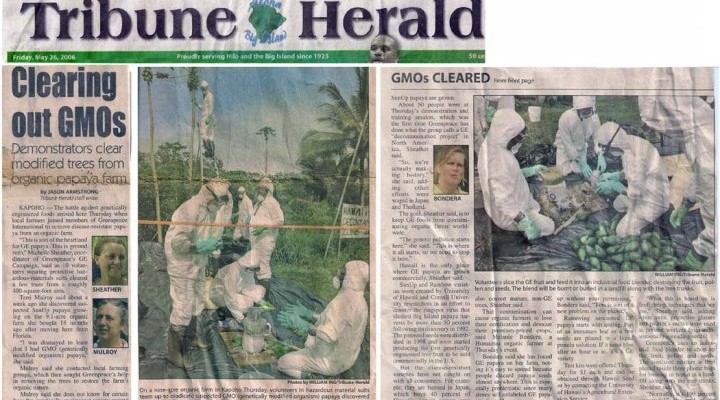May 26, 2006
Clearing out GMOs
Demonstrators clear modified trees from organic papaya farm
by Jason Armstrong, Hawaii Herald Tribune Staff
Kapoho- The battle against genetically engineered foods arrived here Thursday when local farmers joined members of Greenpeace International to remove disease-resistant papaya from an organic farm.
“This is sort of the heartland for GE papaya. This is ground zero.” Michelle Sheather, coordinator of Greenpeace’s GE Campaign, said as 10 volunteers wearing protective hazardous-materials suits cleared a few trees from a roughly 400-square-foot area.
Terri Mulroy said about a week ago she discovered suspected SunUp papaya growing on the 9.1 acre organic farm she bought 18 months ago after moving here from Florida.
“I was dismayed to learn I had GMO (genetically modified organism) papaya,” she said.
Mulroy said she contacted local farming groups, which then sought Greenpeace’s help in removing the trees to restore the farm’s organic nature.
Mulroy said she does not know for certain how the genetically engineered variety arrived on her farm, but suggested wind or birds could have delivered seeds from nearby farms where SunUp papaya are grown.
About 50 people were at Thursday’s demonstration and training session, which was the first time Greenpeace has done what the group calls a GE “decontamination project” in North America, Sheather said.
“So, we’re actually making history,” she said, adding other efforts were waged in Japan and Thailand.
The goal, Sheather said, is to keep GE foods from contaminating organic farms world-wide.
“The genetic pollution starts here,” she said. “This is where it all starts, so we nee to stop it here.”
Hawaii is the only place where GE papaya are grown commercially, Sheather said.
SunUp and Rainbow varieties were created by University of Hawaii and Cornell University researchers in an effort to counter the ringspot virus that slashed Big Island papaya harvests by more than 50 percent following the discovery in 1992. The patented seeds were distributed in 1998 and soon started producing the first genetically engineered tree fruit to be sold commercially in the U.S.
But the disease-resistant varieties have not caught on with all consumers. For example, they are banned in Japan, which buys 40 percent of Hawaii’s annual papaya crop valued at $16 million. GE papaya seeds can germinate amid organic plants and also convert mature, non-GE trees, Sheather said.
That contamination can cause organic farmers to lose their certification and devalue their premium-priced crops, said Melanie Bondera, a Honaunau organic farmer at Thursday’s event.
Bondera said she has found GE papaya on her farm, noting it’s easy to spread because people discard papaya seeds almost anywhere. This is especially problematic since many stores sell unlabeled GE papaya, she said.
“It just feels like such an invasion to try to run an organic farm and these GE seeds show up without your permission,” Bondera said. “This is sort of an new problem on the planet.”
Removing unwanted GE papaya starts with testing. GE papaya starts with testing. Part of an immature leaf or a few seeds are placed in a liquid protein solution. I it turns blue after an hour or so, it’s a GE variety.
Test kits were offered Thursday for $1 each and can be obtained through Hawaii Seed or by contacting the University of Hawaii’s Agricultural Extension Service.
Once a GE tree is detected, the pollen, fruit and seeds must be destroyed.
“What this is based on is firefighting techniques that we use,” Sheather said, adding white suits, protective glasses and painter’s masks were used to prevent workers from unintentionally spreading seeds.
Greenpeace uses an industrial food blender to chop up the fruit, pollen and seeds. The sterilized mixture is then placed in three plastic bags for burning or burial in a landfill along with the tree trunks, Sheather said.
“Normally, it’s 100 percent successful,” she said of the labor-intensive process.
